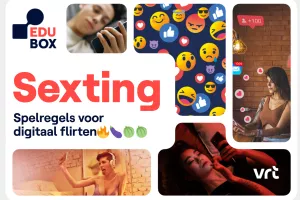The rise of digital media has turned our love and sex lives upside down. While we used to send each other love letters and red roses, today we prefer to do sexting to show our feelings. But what exactly is sexting? Why is it booming among young people? And doesn't sending spicy photos carry all kinds of risks?
Target group: young people (13-18 years)
The EDUbox Sexting guides students through the world of digital flirting and explains that sometimes things can also go wrong.
The EDUbox Sexting consists of 5 parts:
- Part 1 introduces students to sexting. What exactly is it? Why should you do it? Do girls and boys deal with sexting differently?
- In part 2, pupils delve deeper into the ground rules of sexting. They are given a checklist and a flagging system to help them assess whether a situation is transgressive. They learn more about the rules of recognition, the importance of consent and the legal side of things.
- In Part 3, students get to work on their own. They gain insight into the crucial role of ‘bystanders’ in cross-border sexting through a methodology involving chat conversations.
- In part 4, students discover the latest forms of sexting, such as grooming, sextortion and deep nude. And how are artificial intelligence making these practices even more complex to track? They learn what steps they can take if things go wrong and who they can turn to.
- In part 5, we link to additional interesting material on the topic, fully tailored to young people.
About this resource
The rise of digital media has turned our love and sex lives upside down. While we used to send each other love letters and red roses, today we prefer to do sexting to show our feelings. But what exactly is sexting? Why is it booming among young people? And doesn't sending spicy photos carry all kinds of risks?
Target group: young people (13-18 years)
The EDUbox Sexting guides students through the world of digital flirting and explains that sometimes things can also go wrong.
The EDUbox Sexting consists of 5 parts:
- Part 1 introduces students to sexting. What exactly is it? Why should you do it? Do girls and boys deal with sexting differently?
- In part 2, pupils delve deeper into the ground rules of sexting. They are given a checklist and a flagging system to help them assess whether a situation is transgressive. They learn more about the rules of recognition, the importance of consent and the legal side of things.
- In Part 3, students get to work on their own. They gain insight into the crucial role of ‘bystanders’ in cross-border sexting through a methodology involving chat conversations.
- In part 4, students discover the latest forms of sexting, such as grooming, sextortion and deep nude. And how are artificial intelligence making these practices even more complex to track? They learn what steps they can take if things go wrong and who they can turn to.
- In part 5, we link to additional interesting material on the topic, fully tailored to young people.
About this resource
- primary-sexting sexting sexting-gone-wrong talking-to-teens-about-sexting






